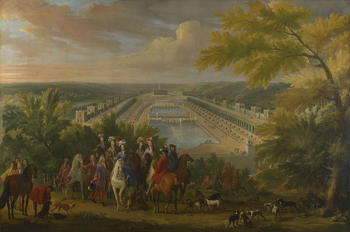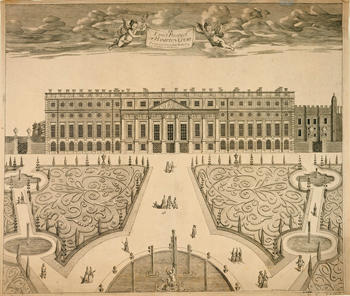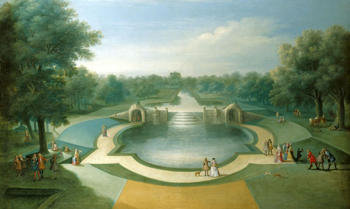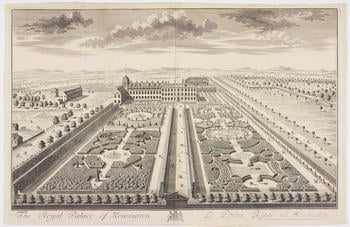
The Baroque Garden and the Artist
The formal seventeenth-century garden was full of exciting new features which engaged artists.

A Hawking Party at Marly, by Jean-Baptiste Martin ©
Axial plans and long views
Long views aligned on a building were promoted by the French garden designer André Mollet (d. c.1665) in his treatise Le Jardin de Plaisir (1651). These new extremes of depth in the garden could be re-created for dramatic effect on the two-dimensional picture plane through the mastery of the rules of single-point perspective.

An exact prospect of Hampton Court by Sutton Nicholls ©
Parterres
Parterres – ornamental flower gardens – provided a pleasing symmetry and decorative appeal. This could be exploited from ground level or in the aerial view, which became the standard form of presentation of the garden, both in print and on canvas.

A View of the Cascade, Bushy Park Water Gardens, c.1715, Studio of Marco Ricci ©
Water Features
‘Water and fountains are the most important ornament in gardens’ wrote the garden theorist Antoine-Joseph Dezallier d’Argenville in 1709. Great cascades, or water-staircases, were particularly favoured in Italy and France; in England single jet fountains were preferred. Long canals also appeared for the first time and feature in Baroque garden art.

Birds in a Landscape, c.1691 – 1714, Jakob Bogdani ©
Aviaries
Aviaries had been a feature of gardens since ancient times. They became increasingly popular in the seventeenth century, particularly in the Dutch Republic and in England after the accession of William III and Mary II. Artists exploited the new fashion by producing large-scale paintings of wildfowl in formal garden settings.

A marble vase in the Medici Gardens, Rome, 1656 by Steffano della Bella ©
Urns
Monumental carved urns and vases formed part of the artist’s repertory from the mid-seventeenth century. Urns and vases enriched the formal garden by their evocation of the classical past and also provided useful ‘punctuation’ to emphasise the regularity and geometry of garden layouts.
Attributed to Jean-Baptiste Martin (1659-1735)
A Hawking Party at Marly
Sutton Nicholls (active 1680-1740)
An exact prospect of Hampton Court
Studio of Marco Ricci (Belluno 1676-Venice 1730)
A View of the Cascade, Bushy Park Water Gardens
Jakob Bogdani (c. 1660-1720)
Birds in a Landscape
Johannes Kip (1652/3-1722)
The Royall Palace and Town of Windsor
Bowles, John : Mercers Hall, Cheapside.
The Royal Palace of Windsor Castle
Overton, H. & Hoole, J.: White Horse, without Newgate, London
The Royal Palace of Kensington
Sutton Nicholls (active 1680-1740)
An exact prospect of Hampton Court
William Henry Toms (c. 1700-c. 1750)
St James's Palace and Parts adjacent.
Lille Tapestry Factory
The formal garden
Adam Weisweiler (1744-1820)
Cabinet
Attributed to Jean-Baptiste Martin (1659-1735)
A Stag Hunt at Versailles
Attributed to Adriaen van Diest (c.1655-1704)
Buckingham House
Ludolf de Jongh (Rotterdam 1616-Hillegersberg 1679)
A formal Garden: three Ladies surprised by a Gentleman
Studio of Marco Ricci (Belluno 1676-Venice 1730)
A View of the Cascade, Bushy Park Water Gardens
British School, 17th century
A Garden
Hendrick Danckerts (c. 1625-c. 1685)
Hampton Court Palace
Leonard Knyff (1650-1722)
A View of Hampton Court
Thomas Tompion (bapt.1639 d. 1713)
Sundial
Sir Godfrey Kneller (1646-1723)
Henry Wise (1653-1738)
Attributed to British School, 18th century
Windsor Castle
Jakob Bogdani (c. 1660-1720)
Birds in a Landscape
Adriaen Kocks (d. 1701)
Pair of tulip vases
After Daniel Marot (1663-1752)
Eight wall hangings
Adriaen Kocks (d. 1701)
Tulip vase
Jakob Bogdani (c. 1660-1720)
Flowers in a Vase
Antwerp [Belgium]
Tapestry of a pergola
Jakob Bogdani (c. 1660-1720)
Flowers in a Vase
Dutch School, 17th century
View of the Amphitheatre in the Tiergarten, Cleves, from the North
Hubert Le Sueur (c. 1580-1658)



























